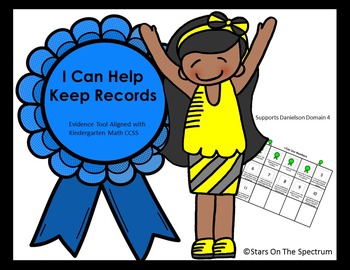Data Notebook * Kindergarten Math Common Core * Record Keeping
Stars On The Spectrum
1.8k Followers
Grade Levels
K
Subjects
Resource Type
Standards
CCSSK.CC.A.1
CCSSK.CC.A.2
CCSSK.CC.A.3
CCSSK.CC.B.4
CCSSK.CC.B.5
Formats Included
- PDF
Pages
38 pages
Stars On The Spectrum
1.8k Followers
Description
Data Notebook for evidence.
Recently, many teacher evaluation methods (i.e. Danielson)
require students to be involved in record keeping activities. “I Can Help Keep Records” was designed to provide younger children with a colorful, easy way to participate in maintaining their own Data Notebooks, and correlates with the C.C.S.S. for Kindergarten Math. Even if not required by your district, it is a terrific way for children to take ownership of their learning and have a visual representation of their progress. In addition to sections for each math domain, there are pages for non-instructional records such as returning permission slips and homework. A third component encourages self assessment of understanding and contains a Marzano type scale poster (color and black and white) with small printable forms which students can use to rate their understanding of any lesson or assignment.
Data Notebook | Danielson | Charlotte Danielson | Charlotte Danielson Evaluation | Charlotte Danielson Evaluation Model Charlotte Danielson Evaluation Framework | Evaluation | Evidence | Artifact | Artifacts | APPR | Core Curriculum State Standards | C.C.S.S | teacher evaluation | kindergarten | Kindergarten | Data | Data Notebook | record keeping |
Recently, many teacher evaluation methods (i.e. Danielson)
require students to be involved in record keeping activities. “I Can Help Keep Records” was designed to provide younger children with a colorful, easy way to participate in maintaining their own Data Notebooks, and correlates with the C.C.S.S. for Kindergarten Math. Even if not required by your district, it is a terrific way for children to take ownership of their learning and have a visual representation of their progress. In addition to sections for each math domain, there are pages for non-instructional records such as returning permission slips and homework. A third component encourages self assessment of understanding and contains a Marzano type scale poster (color and black and white) with small printable forms which students can use to rate their understanding of any lesson or assignment.
Data Notebook | Danielson | Charlotte Danielson | Charlotte Danielson Evaluation | Charlotte Danielson Evaluation Model Charlotte Danielson Evaluation Framework | Evaluation | Evidence | Artifact | Artifacts | APPR | Core Curriculum State Standards | C.C.S.S | teacher evaluation | kindergarten | Kindergarten | Data | Data Notebook | record keeping |
Total Pages
38 pages
Answer Key
N/A
Teaching Duration
N/A
Report this resource to TPT
Reported resources will be reviewed by our team. Report this resource to let us know if this resource violates TPT’s content guidelines.
Standards
to see state-specific standards (only available in the US).
CCSSK.CC.A.1
Count to 100 by ones and by tens.
CCSSK.CC.A.2
Count forward beginning from a given number within the known sequence (instead of having to begin at 1).
CCSSK.CC.A.3
Write numbers from 0 to 20. Represent a number of objects with a written numeral 0-20 (with 0 representing a count of no objects).
CCSSK.CC.B.4
Understand the relationship between numbers and quantities; connect counting to cardinality.
CCSSK.CC.B.5
Count to answer “how many?” questions about as many as 20 things arranged in a line, a rectangular array, or a circle, or as many as 10 things in a scattered configuration; given a number from 1-20, count out that many objects.





